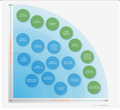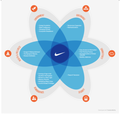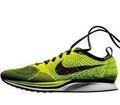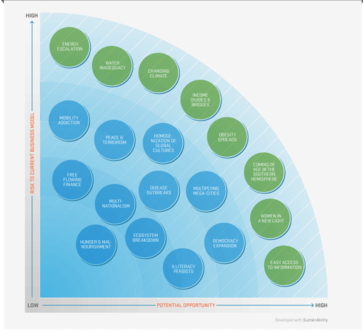by: Mirjam Visser, 2012-08-02 07:30:54 UTC
Sustainability Aspects: Integrating sustainability in a business (strategy), Nike moved from risk management to value add through sustainability. And we all know if it helps the bottom line it is likelier that it will be effectively implemented as a main driver of business
The Story

Condensed from Nike’s sustainability chapter in their corporate responsibility report.
THE SUSTAINABILITY DRIVERS
- Competition for scarce natural resources affects the cost and availability of the inputs needed to make our products, and in turn, the price and availability of the products themselves
- Rising energy costs and greenhouse gas emissions lead to increasing pressure on traditional models of product manufacturing and transportation
- Persistent global disparity in access to financial and other opportunities influence workers throughout our supply chain
- Continued urbanization and the growing middle classes create new demands for products and services, and new opportunities to meet them
- Emerging regulations related to materials use, labor practices and other issues continue to shape our business environment
THE VISION
is to build a sustainable business and create value for Nike and our stakeholders by decoupling profitable growth from constrained resources.
THE RISKS AND OPPORTUNITIES
see picture
SUSTAINABLE INNOVATION
Sustainability is the world’s greatest innovation challenge. Although incremental improvements play an important role, on their own they will fall far short of achieving the progress that’s needed. Retrofitting and fine-tuning the approaches of the past will simply not solve the problems we face. The world needs new systems, new business models, new relationships and new ways of thinking. Sustainability requires transformation, and innovation lies at the heart of that process.
Nike is maintaining a relentless focus on sustainable innovation, from evolutionary enhancements to disruptive shifts that can transform the industry.
As they continue to innovate across their entire value chain, sustainability will be an engine for growth. For example, Nike created jerseys for the 2010 World Cup that were made from recycled plastic bottles, and have built tools such as the Nike Materials Sustainability Index make it easy for designers to create products with lower environmental impacts. Through other initiatives are helping the supply chain become leaner, greener, more equitable and empowered. One example is employing fundamentally different processes to make products, like Nike Flyknit’s innovative manufacturing process, which reduces waste in knitting together the upper of the shoe by stitching it together with just one tread. Another is exploring new materials and manufacturing processes through our Sustainable Business & Innovation Lab.
Nike launched the Lab as a business development and strategic partnership team within Nike that helps drive innovation and collaboration, particularly as it relates to sustainability. The Lab is an expression of our culture and commitment to collaboration and innovation; they believe leveraging innovation in sustainability can be a vehicle for growth and will help us accelerate our vision for superior performance and minimum impact products. Recommendations that come from the Lab, as with any other area of the Nike business, are reviewed by management for alignment with our strategic and financial goals.
SUSTAINABILITY PILLARS
These 4 pillars do not stand alone – they are interconnected. The work Nike does today to optimize and deliver positive impacts also drives insights into disruptive innovations that will create its future.
- Creating a portfolio of sustainable materials.
The choice of materials has a cascading effect across the entire value chain. From farms and factories to trucks and ships to stores and homes where Nike’s products are used and laundered, materials drive its footprint. For the past decade, they have worked to improve the environmental attributes of the materials used while maintaining the highest standards of product performance. The materials rating tool, the Nike Materials Sustainability Index (Nike MSI) is embedded in the indexes that Nike’s designers and developers use to assess potential products, and it plays a pivotal role in product design. Materials are a substantial cost, so identifying long-term access to affordable materials that meet environmental standards is key to ongoing success and ability to decouple materials from scarce resources.
- Prototyping and scaling sustainable sourcing and manufacturing models
directly affects the activities at the heart of Nike’s value chain. Nike’s vision is to create a sustainable supply chain across all of our brands that is lean, green, equitable and empowered. They expect this transformation to benefit the business as well as hundreds of thousands of workers worldwide. Their new Manufacturing Index, launching in 2012, will place a factory’s performance and sustainable manufacturing practices on equal footing and performance with the traditional measures of quality, delivery and cost, for sourcing evaluation. See info-graphic for more detail.
- Igniting and driving market transformation
is about creating the conditions for sustainable consumption to thrive. This requires mobilizing key constituents (such as civil society, employees, government and industry) to partner in driving solutions to scale. It depends on sharing knowledge and expertise across companies and entire industries to broaden the adoption of sustainable principles and practices (see info-graphic for examples). Above all, they must engage consumers in sustainability. Nike begins and ends with the consumer. Inform and meet consumers’ growing expectations in this area, such as through Nike Better World, which is its brand commitment to serve the needs of athletes and the planet at the same time.
- Creating digital services revenue
describes Nike’s vision to extend leadership in athletic footwear, apparel and equipment into the digital realm of fitness, coaching and training services. This will help grow business while diversifying the company away from the natural resources we depend on today.
COLLABORATION TO INCREASE SCALE
Much of the focus is on suppliers, due to the scale of the opportunities in the supply chain. For example:
- The H2O*Insight Water Tool, which was developed for the Nike Water Program and have recently made available through subscription to other companies, enables our vendors and other brands worldwide to more effectively track water quantity, quality and efficiency indicators.
- Nike worked with other footwear and apparel companies to create a roadmap for achieving the goal of zero discharge of hazardous chemicals by material vendors and contract manufacturers by 2020.
- Also in 2011, we joined with other leading apparel and footwear brands, retailers, manufacturers, nongovernmental organizations (NGOs), academics and the U.S. Environmental Protection Agency to launch the Sustainable Apparel Coalition. We have shared our tools with them to help create an industry-wide index for measuring and evaluating product sustainability (see Product Design & Materials chapter).
- Working with other leading brands and the Fair Labor Association (FLA) to create key performance indicators linked to the FLA’s principles of fair labor and responsible sourcing. Common standards will increase consistency in measuring and reporting supplier performance and improve collaboration among brands.
But also outside of the supply chain there are initiatives for example
- GreenXchange, a web-based marketplace founded by Nike with several other companies in 2009, open innovation with other businesses, set up to allow organizations to collaborate and share intellectual property. Nike has gained significant insights from this collaboration to bring sustainability innovations to scale.
Images

Risk & Opportunities

Meta-trends

Flyknit trainer

Risk & Opportunities
by Nike

Comments by our Users
Be the first to write a comment for this item.